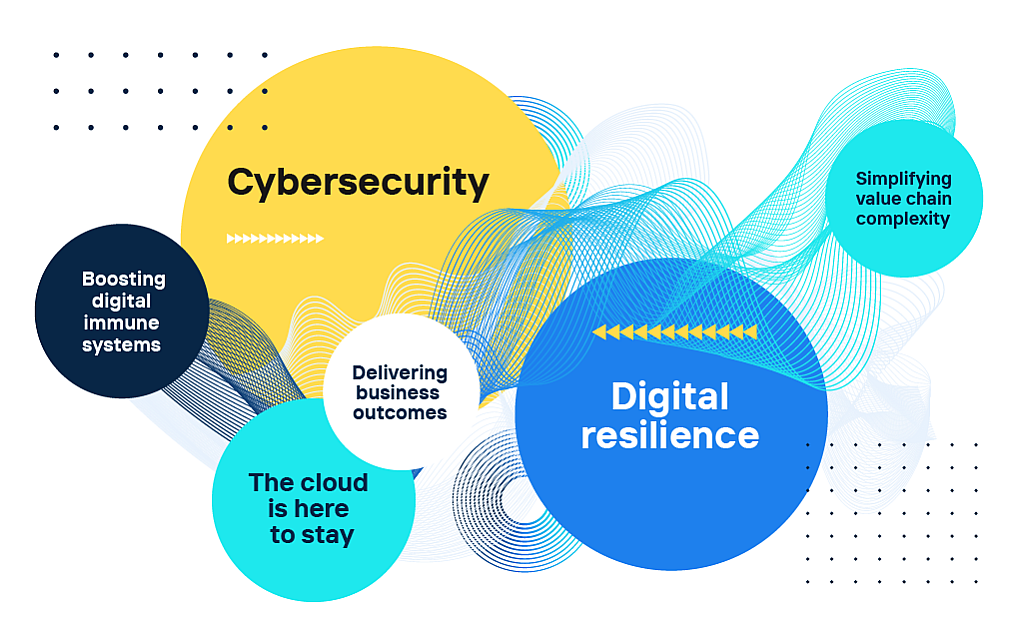According to a Gartner 2023 trends projection, 94% of CEOs seek to maintain or accelerate the digital transformation expedited by the pandemic. And though the COVID lockdowns slashed decades‑long tech modernization roadmaps to a matter of just days and weeks, as a Twilio report put it, many organizations still face roadblocks. What’s more, the war in Ukraine and its ensuing sanctions, compounded by skyrocketing gas prices and supply chain disruptions, have urged organizations to identify ways to secure financial efficiency and focus on value-generating digitization projects, notes KPMG. Meanwhile, a 2021 Gartner survey stated that 88% of company boards saw cybersecurity as an actual business risk, rather than just an IT problem, and the next year Gartner predicted that at least 50% of C-suite executives would have cybersecurity risk-related performance requirements in their contracts by 2026. The list of leaders’ consistent priorities and their high percentiles goes on.
Now as 2023 rolls in, we have our eyes fixed on a set of particular business challenges. No doubt there are many more that we’ll track, troubleshoot, and triumph over. However, these six top challenges are universally applicable and, with the help of solutions that infuse organizations with tailormade resilience, universally solvable.
1) Boosting digital immune systems
While digital hygiene has become a given in any well-run IT system, the future demands digital immunity. To achieve this, traditional monitoring practices must be superseded by the greater, more holistic observability of application lifecycle development. This ensures IT delivers exactly what it was engineered to deliver and does so intact with end-to-end security and scalability. According to a Gartner 2023 trends prediction, if organizations invest in digital immunity by 2025, they’ll increase customer satisfaction by cutting downtime by 80%.
For 2023…we expect organizations to better appreciate the value of having a robust digital immune system. That requires a whole constellation of engineering, design, IT, data analytics, and IoT solutions that can evolve to support technology’s dynamism. Such a system activates the right people, processes, and plans at the right time and place. In short, if there’s an operational or security-related threat, immunity kicks in. As such, organizations can enjoy business continuity, meet market demands, mitigate risks, and, in instances when failure is inevitable, swiftly recover and resume.
To troubleshoot a tech problem while also responding with a business-benefitting solution, all relevant departments and expertise must be present and involved. This principle, which we refer to as “the whole system in the room,” permits all the experts to get engaged – and to stay engaged from start to finish. From there, collective focus falls on the craft of operations. That, in turn, contributes to the stability, security, agility, and scalability that build up a healthy digital immune system.
2) Cybersecurity as the desired byproduct of digital trust
Experts agree: cyberattacks are firmly a question not of if but when. It’s unsurprising, therefore, that 94% of the C-suite expect their organizations will experience a significant cybersecurity incident in the next two years, according to IBM. Forbes notes how 84% of that same cohort reported being targeted by at least one cyberattack in the past year. Research by Gartner concludes that ransomware is the most significant audit risk for auditors and management to consider in 2023.
For 2023…we expect an even greater rise in cyberattacks. This is thanks to the advancement of attack technology itself along with the enhanced professionalization of hackers, their coding savvy, and social engineering toolkits. Plus, in the wake of pandemic lockdowns, more people work from home, where there may be poorer network security and additional available attack surface. Meanwhile, ransomware now ranks as the highest cybersecurity threat by the National Coordinator for Counterterrorism and Security. Organizations will be forced to see that warding off cyberattacks requires more than patching and backups. Cybersecurity is no longer merely an IT issue, but the responsibility of the entire C-suite, all of whom have a stake in upholding business continuity, reputation, and accountability. To protect and soundly lead businesses, they must invest in every person, process, and application that can contribute to identifying risks and implementing security measures.
Cybersecurity is not a toolkit or a designated team, but the desired byproduct of digital trust. And digital trust is a matter of practice. It is laboriously refined through constant upkeep of tech hygiene, differentiating mission-critical workloads from non-critical, staying aware of security threats, and detailed planning, which today must include the mapping of cyber kill chains and building controls to mitigate any attack. This has gained urgency as IT environments progressively interlink and integrate more third-party services. By practicing digital resilience, organizations can better predict and prepare for whatever may come while selecting solutions to help ensure all systems function optimally, stably, and securely.
3) Digital resilience in an increasingly regulated world
The future is digital, people once said, but with over 63% of the world population now using the internet, we can now say that much of humankind is digital. Since the start of the pandemic, 125 million new consumers have adopted digital channels in the United States and Europe alone, according to 2022 McKinsey survey. Meanwhile, 2022 findings by Gartner show that over 75% of governments will operate more than half their workloads via hyperscale cloud providers by 2025, and by 2024, that same number will have at least three organization-wide hyperautomation projects running. It’s unsurprising, therefore, that at the freshly concluded AWS re:Invent 2022 conference, as McKinsey observed, “one topic remains top of mind for tech leaders: digital resilience.”
For 2023…we expect that the more lives become digitized, the more demanding data and privacy regulations will become. This will require institutions, both public and private, to practice more digital resilience. Concretely, the practice involves nurturing policies and procedures to guarantee that they, their end users, and society at large can use technology safely, legally, and privately. Due to go into force in early 2023, the Digital Operational Resilience Act (DORA), for example, will push Europe’s financial institutions to have implemented security programs, detailed incident reporting and auditing, and risk management plans. Within these plans, they’ll have to include a cloud exit strategy that enables them to maintain control and avoid overreliance on any one hyperscaler. But supported by data, cybersecurity, and auditing solutions, organizations can pursue strategies that allow them to stay secure and compliant while honoring their commitment to business continuity and new value creation.
Risk analysis is the bedrock of compliance, and within mission-critical IT strategies, risk areas must be anchored. Tech today must provide IT that is not only highly performant, but also capable of protecting customers’ data while meeting the dynamic reporting demands of multilevel regulatory bodies. While for a long time, the many requirements may have overwhelmed organizations – or in some cases, paralyzed them from progress – proper risk assessment holds the promise of a more digitally resilient path forward. This is all the more urgent as usage of the public cloud, XaaS providers, and other third-party services adds complexity to regulatory interpretation and compliance. Highly automated auditing solutions that can provide real-time data are key to compliant-by-design IT. So is having access to compliance and security experts who can untangle regulatory complexities and their varying implications, depending on the business, its unique demographics, ambitions, and risk appetite.
4) Delivering not just digital projects but business outcomes
Digital transformation has become a given for modern-day organizations, yet many are hindered because they focus on what Forrester’s vice president and principal analyst has pointed out are “back-office technology assets” rather than the tech’s actual business outcomes. To make projects more value-driven and value-generating, an organization’s tech teams must, as a recent CIO article advises, “plan, manage, and report in business terms.” Currently, less than 5% of CIOs discuss or measure the business outcomes from the technology they deploy, also reports CIO. Plus, many business leaders haven’t seen the revenue or cost impact they anticipated from their digital strategy and investments, finds a McKinsey Global Survey.
For 2023…we expect organizations to accept that digitization is simply inevitable. IT is no longer a sole department, but an omnipresent component of business necessary to sustain business longevity. As such, organizations will enjoy greater success the more their C-suite executives and tech experts can strategize together. Instead of operating in silos or communicating only within their own department, CIOs and their IT teams have a stronger chance at getting their needs met if they speak the language of company leaders. This entails pitching what they do not as some work on a tech project, but as a crucial means to achieve business outcomes. By concentrating on business value as opposed to technological virtue, IT comes to be seen as a generator of cost savings, revenue growth, risk mitigation, sustainability measures, and employee happiness.
Where IT needs end and business needs begin is fuzzy. Customers requesting tech solutions are frequently organizations seeking value creation. So while professional experience and expertise should guide tech execution, what brings business solutions to life requires more than that. It takes getting to know and understand the people who work in an organization and how they’re impacted by its everyday processes and equipment. From there, it’s a matter of identifying each opportunity where IT can unite the whole customer ecosystem and fuse digital technology with business strategy.
5) Accepting that the cloud is here to stay
Cloud migrations have been underway since the 1990s, and today the cloud provides the foundation for any digital or data-driven strategy. According to an AWS C-Suite 2022 Report, 98% of executives see it as a crucial driver of digital transformation. For the same report, enterprise customers surveyed from across 15 markets and 10 industries cited the private cloud, specifically, as their most preferred model. In a report by EY-NASSCOM, 80% of surveyed C-suite executives said they will increase their cloud budgets over the next 12 months.
For 2023…we expect the cloud to serve as an even more powerful piece to the digital immune system puzzle. As organizations harness their own ability to minimize risks from global disruption and comply with international data privacy regulations, they’ll demand more hybrid setups. Hybridity can offer the best of both words: protecting mission-critical workloads in a trusted private cloud while also exploiting the public cloud’s vast, fast, and cost-effective features. A sovereign cloud, in particular, can answer the needs of organizations seeking to fulfill national data requirements and restrict jurisdictional control and compliance to one specific country.
The cloud has become indispensable to IT ecosystems today. Yet, there’s no one-size-fits-all solution, especially for organizations with mission-critical workloads. Whether a private, public, or hybrid cloud setup is right, two priorities must prevail: ensuring the cloud generates value for a business and unburdening the customer of all technical worries. In other words, the right cloud setup has become as much an instrument of IT modernization as the basis for a robust and resilient digital immune system.
6) Simplifying value chain complexity
Many observers agree that 2023 will be marked by global recessions, and with them, supply chains will still be disrupted by product shortages as well as transport and logistical delays. And yet, less than 50% of companies can say that they understand the location of their tier-one suppliers or the risks these suppliers face, according to a 2022 McKinsey article. That figure falls to just 2% for tier-three suppliers and beyond, the survey found. What’s more, Gartner predicts that by 2025, 45% of organizations will undergo software supply chains attacks.
For 2023…we expect value chain complexity will have a real shot at simplification if more sectors can incorporate more IoT features. Focused on data-informed decision-making and data-driven action-taking, IoT solutions yield sharper, faster actionable insights. These insights can be used to control processes in real time and predict business more precisely than ever. By reengineering their internal systems with tools that enable data extraction and analytics, AI, and machine learning, organizations can distribute their tasks efficiently and improve collaboration among employees and partners. From there, even in a world characterized by volatile market pricing, supply shortages, and inflation, digital supply chain networks can drive growth and profitability.
No matter how complex their manufacturing lines or global their footprint, organizations often have valuable insights right at their fingertips. To unlock this value, the manufacturing, transport, and logistics sectors must embrace digital tools. These tools should be built with the expert knowledge and real-life experience of their actual users, such as the shopfloor operators in a factory. This way, relevant data becomes democratically accessible and actionable, making work easier and more enjoyable for those who do it. Information then becomes widely applicable across sites and scalable across locations. That, in turn, creates a domino effect of predictable, data-driven efficiency and profitability along the whole value chain.





